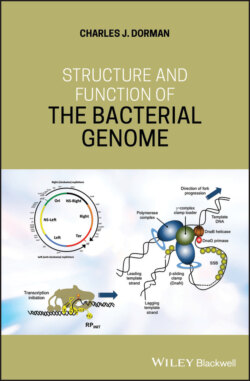Читать книгу Structure and Function of the Bacterial Genome - Charles J. Dorman - Страница 62
1.51 H‐NS Functional Homologues: Lsr2 from Actinomycetes
ОглавлениеThe 12‐kDa Lsr2 NAP has been described as a functional analogue of H‐NS in actinomycetes, including Mycobacterium spp. (Datta et al. 2019a; Kriel et al. 2018). It targets genes that have high A+T content that are thought to have been acquired by HGT (Gordon et al. 2010). Like H‐NS, it can form DNA–protein–DNA bridges (Chen, J.M., et al. 2008), has a similar domain structure, and it can substitute functionally for H‐NS (Gordon et al. 2008). Lsr2 and H‐NS also bind DNA in the minor groove through a similar mechanism: using a so‐called AT‐hook‐like grip (Gordon et al. 2011). The similarities between Lsr2 and H‐NS are primarily functional and probably arose by convergent evolution: their amino acid sequences and their DNA‐binding domains have distinct tertiary structures (Gordon et al. 2010, 2011; Shindo et al. 1995). Like H‐NS, Lsr2 can polymerise along DNA to form stiff nucleoprotein structures from which other DNA‐binding proteins are excluded (Qu et al. 2013).
Rv3852 is a 13.8‐kDa protein that is highly conserved among Mycobacterium spp. and has been annotated as H‐NS because its N‐terminus resembles histone 1 from humans (Cole et al. 1998). Rv3852 is not an essential protein and a careful study of its properties rules out a role for it in controlling the virulence phenotype of Mycobacterium tuberculosis or in compacting the bacterial nucleoid (Odermatt et al. 2017).
